Monstera acacoyaguensis is a rare or uncommon tropical climbing plant native to native to Belize, Guatemala, and Mexico. It is a member of the arum family Araceae or aroids.
This tropical flowering plant has lovely oval, semi-leathery, glossy green juvenile leaves. As it matures, unlike the Monstera deliciosa, Monstera dubia, or Monstera pinnatipartita, whose leaves split, retains the entire margin but develops perforations.
Usually, this Monstera somewhat resembles Monstera lechleriana. But there are distinctions between these two species, as we will see later.
Furthermore, some vendors label it as a rare Monstera Adansonii. However, that isn’t the case. These are two separate Monstera species. For instance, Monstera acacoyaguensis has a longer flower spathe, spadix, and peduncles. Also, their leaf perforations differ.
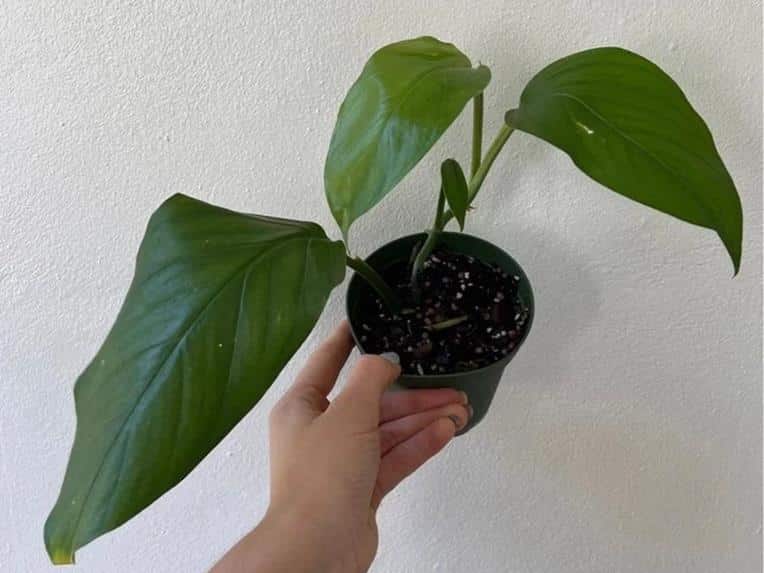
Contents
- Quick Overview
- Identification – appearance and description
- 1. Growing habits
- Size
- 2. Leaves
- 3. Stems
- 5. Flowers
- Where to grow Monstera acacoyaguensis
- Monstera acacoyaguensis care and growth requirement
- 1. USDA hardiness zone
- 2. Optimum temperature
- 3. Humidity
- 4. Light requirement
- 5. Best soil
- 6. Watering
- i. Overwatered Monstera acacoyaguensis
- ii. Underwatered
- 7. Fertilizer
- 8. Pruning and grooming
- 9. Potting and repotting
- Monstera acacoyaguensis propagation
- i. What you need
- ii. How to propagate Monstera acacoyaguensis
- iii. Monstera acacoyaguensis propagation in water
- Toxic to pets and humans
- Pests
- Diseases and conditions
- 1. Root rot
- 2. Yellowing of leaves
- 3. Curling leaves
- 4. Leaves dropping
- Monstera lechleriana vs. acacoyaguensis
- Frequently asked questions
Quick Overview
| Scientific name | Monstera cacoyaguensis Matuda |
| Family | Arum family, Araceae (aroids) |
| Common names | |
| Native habitat | Belize, Guatemala, and Mexico |
| Type | Climbing hemiepiphytes |
| Size | 20 ft (5 m) in native habitat, 4 to 6 feet or more at home |
| Leaves | Oval, sub-leathery, glossy juvenile green leaves and large perforate, sub-leathery, glossy leaves with an entire margin |
| Stems | Green, vine-like stems |
| Flowers | Small, yellowish inflorescence flowers borne on a spadix surrounded by light yellowish to green a thick, leathery spathe |
| Blooming time | All year once the plant matures |
| Light requirement | Bright, indirect light |
| USDA hardiness zone | 11b to 12 |
| Temperature | 65°F to 80°F (18 to 27 ºC), not frost hardy |
| Humidity | Average to above average, typically 50% to 80% |
| Growth rate | Medium |
| Soil | Well-drained, high organic matter, slightly acidic to neutral soils or potting mix |
| Watering | Medium, letting the top 1 to 2 inches to first dry |
| Propagation | Stem cutting |
| Toxicity | Toxic to humans and pets |
| Care level | Low or easy |
Identification – appearance and description
Let us now look at the appearance of Monstera acacoyaguensis. We will talk about growing habits, size, leaves, stems, and flowers.
1. Growing habits
This Monstera is are tropical evergreen hemiepiphytes growing in tropical humid and warm rainforest jungles. Therefore, part of their cycle is an epiphyte (growing on hosts) and the other terrestrial (ground).
Usually, they grow as understory creeping plants or as lower trunks climbers or epiphytes. They mainly receive filtered light or a partial shade.
Finally, Monsterasacacoyaguensis has a medium growth rate. Furthermore, various conditions like light, temperature, nutrients, and a climbing place significantly impact their overall growth rate.
Size
While in its natural habitat, M. acacoyaguensis grows up to 20 feet long (5m) as a lower stem climber. Nonetheless, at home, it will grow up to about 4 to 6 feet long.
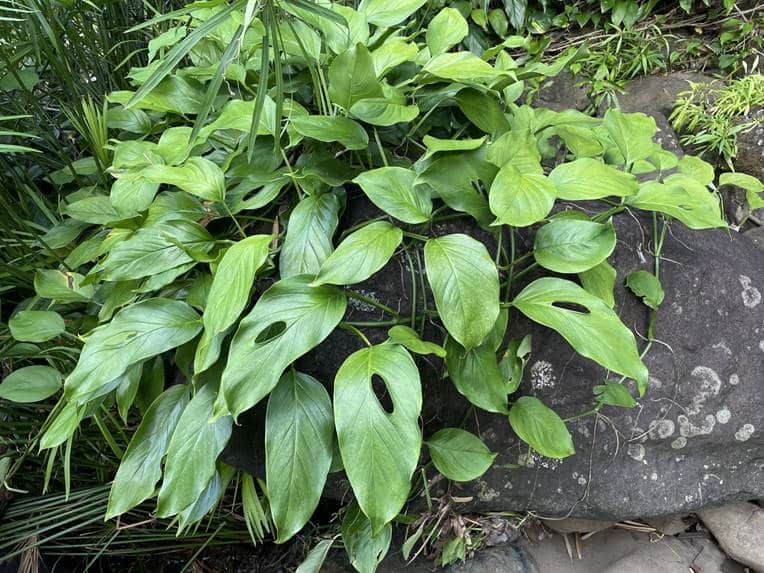
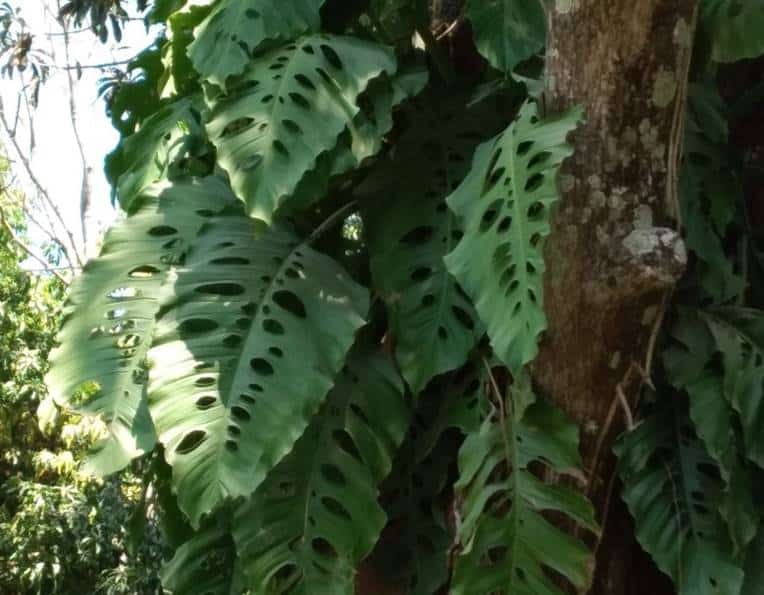
2. Leaves
This Monstera has oval, entire, erect, sub-leathery, glossy green juvenile leaves. Their petioles are sheathed and are about the length of the leaf blade.
On the other hand, the mature Monstera acacoyaguensis plant has large (24-33 inches long and 14 to 18 inches wide), perforated, sub-leathery, glossy green leaves with pale on the underside. However, unlike other Monsteras, the leaves have an entire margin.
Usually, the perforations are in one or two series. They are oval to elliptical, typically measuring 1.5 to 4.7 inches long and 0.8 to 2 inches wide.
Additionally, like juvenile leaves, these plants have sheathed or vaginate petioles and persisting sheathing wings. However, the petioles are more elongated, 16 to 26 inches.
Finally, its adult leaves resemble Monstera lechleriana. But the perforations are more prominent and sometimes arranged in two series. Also, these adult leaves look somewhat like Monstera acuminata but are larger.
3. Stems
Stems of juvenile plants are smooth and greenish. They have internodes that are about 0.8 to 1.6 inches long.
On the other hand, adult or mature plants have subterete, smooth stems with slightly longer internodes (1.1 to 2 inches long). Also, they have leaf scars.
5. Flowers
This Monstera has yellowish inflorescence flowers borne on a cylindrical spadix. The flowers have a thick, leathery light yellow to green spathe. And a terete, smooth flower stalk that is longer than the spadix,
Where to grow Monstera acacoyaguensis
These plants make lovely gardens and houseplants. Inside your home, grow them in pots or hanging baskets. They can withstand average household conditions and indirect light.
Also, you can have them in greenhouse cabinets or a terrarium. Here, you will have easier control of humidity and other conditions.
Since they are climbers, please give them a climbing trellis, moss totem, or pole. However, some people love to place them on desktops, shelves, tables, etc., letting their vines to cascade or grow horizontally.
On the other hand, outside, they can grow as a ground cover. Also, if you can allow them to wrap tree trunks, climb walls, arbors, wood fences, and so on. Nonetheless, ensure they have ideal growing conditions.
Monstera acacoyaguensis care and growth requirement
Monstera acacoyaguensis are easy to care for and low-maintenance. Gardening beginners or newbies will find these ornamentals a perfect choice. You need to know the right growing conditions and a few care tips, and you are good to go.
Let us look at the various care and growth requirement that these aroids need.
1. USDA hardiness zone
Monstera acacoyaguensis USDA hardiness zone is 10b to 12. These tropical plants are not frost-hardy. Thus, frost and freezing temperatures will damage them.
However, if you are in USDA hardiness zone 10b to 12, you can grow these Monsteras outdoors all year.
2. Optimum temperature
Like other tropical plants, Monstera acacoyaguensis prefer a warm place with typical temperatures ranging from 65 to 80 degrees Fahrenheit (8-27ºC). However, they don’t mind slightly higher temperatures, up to 90 degrees Fahrenheit (32ºC).
Lower temperatures will slow growth. And by 50 degrees Fahrenheit (10 ºC), your plants will stop growing. Therefore, if you grow them outdoor, move them indoors when temperatures reach 50°F.
Also, as with most houseplants, avoid sudden drastic temperature changes (dips or spikes) or cold drafts. Also, don’t have them near cooling or heating vents.
3. Humidity
Monstera acacoyaguensis need average to above average humidity, typically 50% to 80%. These are tropical plants that love a humid environment.
Dry air or low humidity may make leaves turn yellow, have brown edges or be crispy. Also, your plant may wilt. So, if you live in below-average low humidity places buy a humidifier. We use LEVOIT Humidifiers Top Fill, 6 Liter, Cool Mist. It has a large coverage area, will run for up to 60 hours and comes with Vesync APP. Also, you can connect it to 3rd party voice assistants like Alexa.
If your humidity isn't too low, you can mist your plants a few times a week, or have a pebble tray. Alternatively, you can place them with other plants, keep them in a bathroom, greenhouse cabinets, or terrarium.
4. Light requirement
Let your Monstera acacoyaguensis grow under bright, indirect light. However, they don’t mind medium, indirect light.
If you live in a place with low light, buy grow light. These plants don’t mind artificial lights. Otherwise, they will grow slowly. Also, their leaves may turn yellow.
On the other hand, don’t put these Monsteras in direct sunlight. Even in their habitat, they grow as understory plants or beneath canopies of tall trees.
Direct sunlight will scorch their leaves and bleach them. When burnt, they will look washed out and have leaves with crispy brown edges and tips.
Therefore, if you live in mild climates where you can grow these Monsteras outdoors, get a place with a shade or filtered light. Alternatively, grow them in a greenhouse or use shade cloth.
Finally, it doesn’t matter whether you have a south, east, west, or north-facing window. Choose a distance to place your plant that ensures no direct sunlight reaches. Also, you can have blinds, especially the south-facing window.
5. Best soil
Grow Monstera acacoyaguensis is a well-drained, aerated, and organic-rich soil or potting mix. Also, the potting mix should be slightly acidic to neutral (pH 5 to 7.5).
These aroids are not fussy on the soil. After all, they grow as epiphytes, deriving nutrients from decaying matter. Therefore, they will take almost anything you offer them.
Well-drained loamy soil, sphagnum moss-based potting mixes are perfect. However, you need to add perlite, bark chips, or pumice are ok. Alternatively, buy an aroid mix from Etsy.com.
Lastly, avoid heavy or poorly drained soils that get soggy. Such mixes are a recipe for root rot.
6. Watering
These love moist and not very wet or soggy potting mix. Therefore, water Monstera acacoyaguensis when the top 1 to 2 inches of the soil is dry, i.e., up to the first knuckle of your finger.
We dont prefer the feeling the potting mix. Instead, we use a moisture meter to know when to water our plants. We love the XLUX since it is easy to read, accurate and responds fast. What is more, you don't need any batteries.
On how often, it will will be after about 5 to 7 days during the growing season and biweekly in winter or fall.However, the exact watering frequency will depend on prevailing conditions (humidity, temperature, light, etc.), plant size, port size, and so on. So, always test the potting mix.
Finally, when watering them, saturate them with water until excess flows from drainage holes. If you have a saucer beneath your pot, discard any collected water.
i. Overwatered Monstera acacoyaguensis
These Monsteras, like many others, are sensitive to overwatering, and it may result in root rot. It may be overwatering if you start seeing yellow leaves and a constantly wet potting mix or soil.
Other common overwatering signs are moldy on top of the soil, wilting, drooping leaves, brown spots with a yellow halo margin, etc.
Finally, besides too much watering, poorly drained soil or pots without drainage holes. Similarly, oversized ones may cause this issue.
ii. Underwatered
Skipping a watering session, soil that doesn’t hold moisture, or conditions that promote quick evaporation may make your plant thirsty.
The obvious signs are arid soil and the drooping or curling of leaves. If not corrected, your plants will grow slowly, drop leaves, or even wilt.
7. Fertilizer
Fertilize these Monsteras about every month during the growing seasons -spring and summer or as recommended by the manufacturer. However, we recommend you start with half the recommended strength.
Don’t fertilize these plants when they are not growing (fall or winter). At this time, they will not use the fertilize. Worse, fertilizers may form salt deposits that will require flushing.
An excellent, balanced formula to use is Miracle-Gro Indoor Plant Food (Liquid). Use one pump for a small to medium or two for large pots. You will notice results almost instantly.
If you prefer something organic, Espoma 8 Ounce Concentrated Organic Indoor Plant Food is another balanced formula you can use. Prepare a ½ a cap per quart of water and use it once monthly.
Lastly, Osmocote Smart-Release Plant Food Plus Outdoor & Indoor is an excellent pick for those who love slow-release fertilizers. It feeds for up to 4 months. Sprinkle 1 a teaspoon per 64 square inches and work it into the soil, about 1-3 inches deep. .
8. Pruning and grooming
These Monsteras don’t need much pruning. However, you should remove any diseased, dead, or damaged leaves to create more room for new growth.
Furthermore, you can occasionally prune some leggy or long vine. Doing so will encourage branching, making you a fuller plant. Also, it will help control its shape.
Finally, to avoid the spread of diseases, ensure you first sterilize your pruning knife or scissor. To sterilize, use rubbing alcohol, bleach, or other household disinfectants.
9. Potting and repotting
Since they don’t have an extensive root system, consider repotting Monstera acacoyaguensis once every 2 to 3 years or if pot or root-bound.
When pot bound, this aroid will be leggy and will have roots growing from drainage holes. Also, they will grow slowly. Leaves may curl, drop, or yellow.
Finally, pick a pot that is 2 to 3 inches in diameter and repot during spring or summer. We don’t recommend repotting in summer.
Monstera acacoyaguensis propagation
Monstera acacoyaguensis propagation is by stem cutting. You can grow this cutting in water or potting mix/soil.
Besides stem cuttings, other possible ways are layering and splitting. However, splitting is only possible if your plant has suckers.
Finally, the best time to propagate this Monstera or any other houseplants is in spring. However, summer is ok but may not give your plant enough time to root.
i. What you need
- Sterilized pruning knife, shear, or scissors
- Potting mix. 50% perlite and 50% peat moss or even peat moss alone.
- Sealable plastic paper bag
- Rooting hormone. We use HydroDynamics Clonex Rooting Gel. This water-based formula has nutrients and trace elements that your plant needs in addition to the rooting hormone.
- Grower or pot
ii. How to propagate Monstera acacoyaguensis
- Fill your pot with potting mix and saturate it with water until excess comes from drainage holes. If it has a saucer, discard whatever collects on it.
- Select and cut a healthy, mature stem about 4 to 6 inches long. It should have at least two nodes. Afterward, remove lower leaves, leaving top one or two.
- Apply some rooting hormone to encourage quicker rooting.
- Make a small hole on your potting mix and plant your stem cutting, covering at least the two lower nodes. Afterward, lightly tamp the soil to help keep the cutting upright.
- Lightly mist your plant and cover it with your plastic bag to help maintain high humidity and keep the potting mix moist. Ensure leaves don’t touch this bag. Also, leave a small opening to give the plant a chance to breathe.
- Put the pot with your cutting it in a warm place with bright, indirect light.
- Routinely, check to see if the soil is still moist. Also, remove the plastic bag for a few hours to allow the plant to breathe.
Your cutting should begin growing roots after 3 to 4 weeks. Later, you will see a bud, and by the end of two months, it should have unfurled at least a new leaf.
Finally, transplant it when roots are at least two inches long or grown enough. Some people choose to let it grow a few leaves before transplanting it.
iii. Monstera acacoyaguensis propagation in water
If you would love to see the roots grow, use a jar with water instead of a potting mix. Also, you don’t have to cover it with a plastic bag. The water will help raise humidity.
Finally, change the water after every 2 to three days or when it starts becoming slightly cloudy. Otherwise, algae will colonize your jar.
Toxic to pets and humans
Monstera acacoyaguensis is harmful to pets and humans, i.e., it is toxic or poisonous to people, dogs, cats, rabbits, and other pets.
This plant, other Monsteras, and a few other members of the Araceae family, such as Alocasia sp., Dieffenbachia sp., Philodendron sp., etc., have insoluble calcium oxalates.
When chewed, the sharp, microscopic calcium oxalate embeds on the mucosa membrane, causing the following symptoms:
- Intense irritation, burning sensation, and pain
- Swelling and redness of lips, tongue, and mouth
- Drooling
- Pawing in pets
- Swallowing difficulties
- Refusal to eat and lack of appetite
- Swollen tongue and throat (rare)
Also, it will cause some burning sensation and irritation if it comes in contact with the skin.
Therefore, if you have pets or kids, limit access to this charming plant. Alternatively, you can go for pet and kid-friendly houseplants.
Pests
Pests are not a big problem when it comes to this Monstera if grown indoors. Nevertheless, they can occur. Here are common pests, signs, and remedies.
| Pest | Signs | Remedies |
| Mealybugs | Presence pink, soft-bodied bugs with powdery wax (the mealybugs), cottony wax, black sooty molds, curly, drying or yellowing of leaves, distorted plant, and slow growth | Use horticultural spray oils, systemic insecticides (outdoors), insecticidal soaps, rubbing alcohol (soak it a cotton swab and apply it on the bugs), |
| Spider mites | Small yellow or white spots on top leave surface, webbing or presence of black, brown, red, or yellowish moving tiny bugs | Hose the plant to dislodge them, use neem oil or insecticidal soaps (effective for severe infestation) |
| Thrip | Spots, yellow speckles and silvery appearance leaves, black spots, distorted young leaves, and the prescience of pale yellow to black bugs on leaves underside | Hose them off your plant, use neem oil spray, insecticidal soaps, or consider a houseplant insecticide to help treat nymphs that may be in the soil. |
| Scale | Oval or round bumps on leaves (the bugs), honeydews, black sooty mold leave discoloration or yellowing | Treatment and management include horticultural oil spray, prune infected branches, rubbing alcohol, insecticidal soaps, neem oil |
Diseases and conditions
Monstera sp. Including this species may suffer from powdery mildew, mosaic virus, southern blight, or rust. Other diseases are leaf spot, root rot, and anthracnose. However, the most common one is root rot.
Let us look at root rot and other disease and conditions:
1. Root rot
Fungal and bacterial root rot happens due to overwatering or waterlogged, poorly aerated soil. Signs include slow growth, yellow leaves, wilting, and a mushy stem. Others are black splotches on leaves, leaves dropping, etcetera.
If caught early, you can control root rot. However, if the damage is too much, your plant will grow.
Some ways to manage the problem include repotting. As you repot your plant, discard old potting mix and trim any brown or black leaves with a sterilized pruning knife
2. Yellowing of leaves
Yellowing leaves in Monstera acacoyaguensis results more often from overwatering. Nevertheless, it may be improper light, lack of some nutrients, or underwatering.
Other possible causes are cold drafts, pests, disease, or aging. It is usual for older leaves to turn yellow them brownish before they fall or dry.
3. Curling leaves
The first suspect in the case of curling leaves is thirstiness. But it could still be low humidity, heat stress, or root rot. Additionally, infestation by pests and some diseases may result in curly leaves.
4. Leaves dropping
Is this aroid dropping or losing leaves? Don't freak. Causes have to do with care and growing conditions. Common ones include:
- Under or overwatering
- Low humidity
- Lack of some nutrients
- Freezing conditions
Also, a pot-bound plant, diseases, or one infested with pests may lose leaves.
Monstera lechleriana vs. acacoyaguensis
Most people confuse Monstera lechleriana and Monstera acacoyaguensis. They do have some resemblance, especially their mature leaves. Nonetheless, there are ways to distinguish these two.
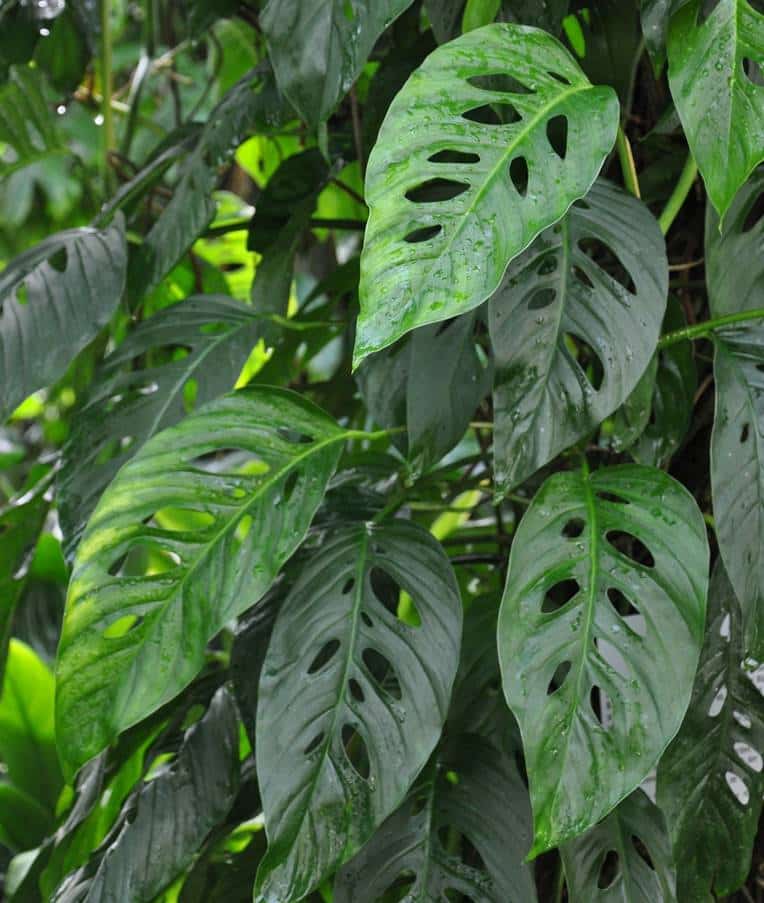
| Feature | M. acacoyaguensis | M. lechleriana |
| Leaves | Many and more extensive perforations with one or two series on either side of the leaf blade | Fewer and smaller perforations with only a single series on either side of the lamina |
| Flower | Narrower spadix with smaller ovaries | Thicker spadix with twice larger ovaries |
| Stem internodes | Longer with leaves not having a tight head | Shorter with leaves held in a closed head |
Frequently asked questions
Is Monstera acacoyaguensis rare?
Yes. Monstera acacoyaguensis is a rare or uncommon garden and houseplant. You are unlikely to find it in most local nurseries or even the larger horticultural growers like Costa Farms. However, we cannot determine if it is rare or unpopular.
What is the Monstera acacoyaguensis price
M. acacoyaguensis price ranges from $30 to $60 for a propagated cutting juvenile with 2 to 3 leaves. However, if you want a cutting with adult leaves, you will spend $100 to as high as $300.
Where do I buy Monstera acacoyaguensis?
As a rare or uncommon plant, start looking for it at your local specialty nurseries or plant stores. Secondly, go to Facebook plant groups near you or eBay.com and Etsy.com. Also, you can google for “Monstera acacoyaguensis for sale” to see if anyone has it around you.
Other places to find this Monstera include Peaceloveandhappiness.club ($38), Pottedelephant.com $25.00, Canopyplantco.com ($50), and Kensphilodendrons.com.
People in the UK, Canada, and Australia should try Etsy.com or eBay in their location. This plant is not readily available.


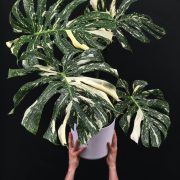
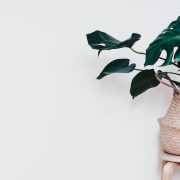
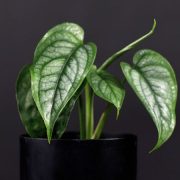
Leave a Reply